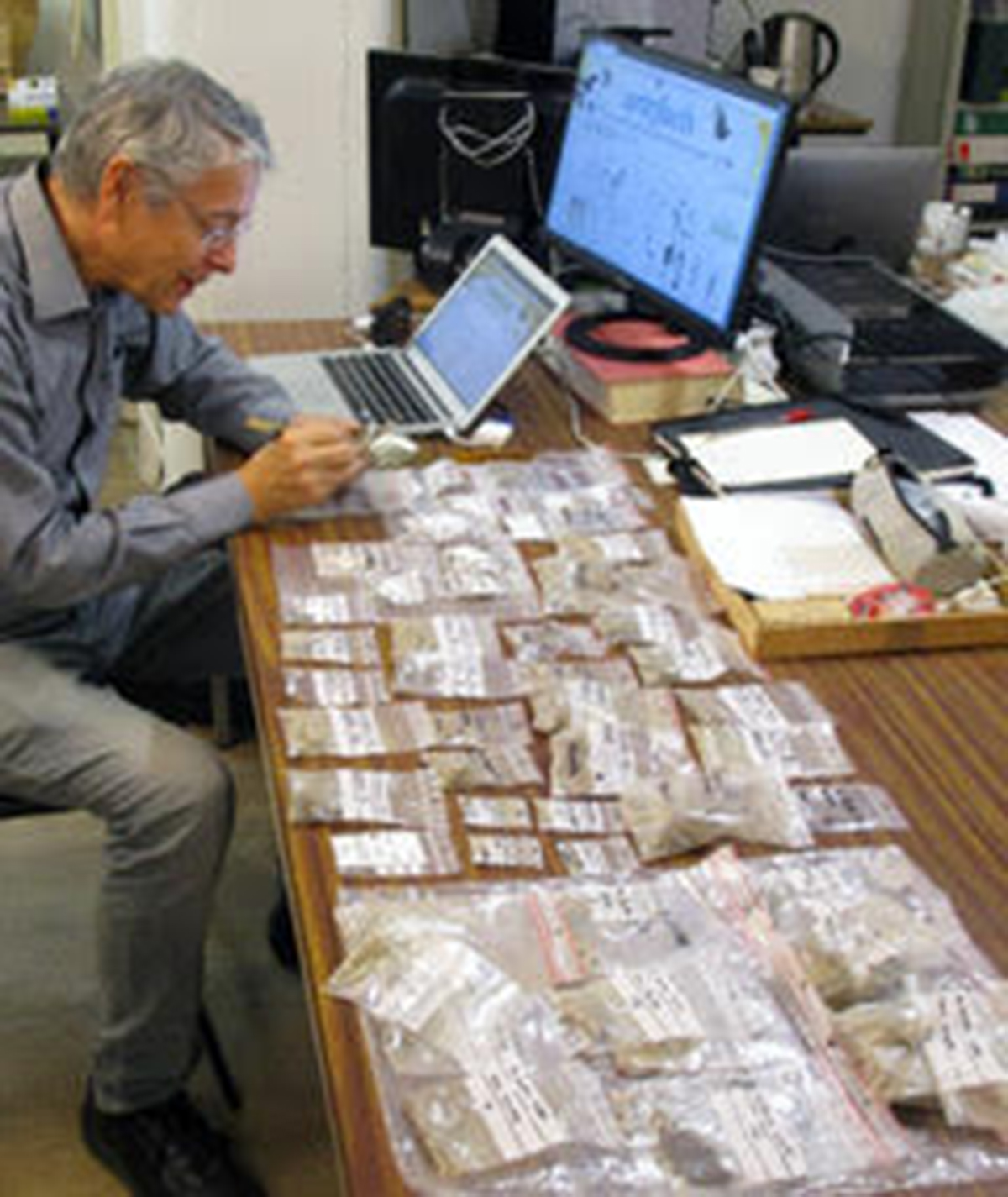In the context of our Irish theme for the year 2009, the Centre Culturel Irlandais (Irish Cultural Centre – CCI) was a must to discover the history of the Irish and their community in France and Paris. So, on Wednesday 11th March, ArkéoTopia® brought together its members and a few curious souls for an ArkéOdyssée on-site followed by a discussion at the Saint-Hilaire pub.
This outing was also the opportunity to broach, thanks to from the CCI’s heritage collection, the topic of illuminated manuscript prduction which was to be seen in greater detail at the ArkéoCafé of 24th April and the ArkéoCiné of 16th May concluding in Dublin with the presentation of the Book of Kells at Trinity College.
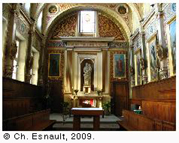 The small group met in the CCI’s courtyard, transporting its passengers into another time, as one of the participants later pointed out. There, under the direction of Carole Jacquet, head of libraries and archives at the CCI, the visit began with Saint Patrick’s chapel..
The small group met in the CCI’s courtyard, transporting its passengers into another time, as one of the participants later pointed out. There, under the direction of Carole Jacquet, head of libraries and archives at the CCI, the visit began with Saint Patrick’s chapel..
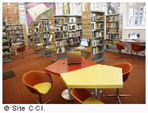 This was followed by the multimedia library, the heritage library and concluded in the exhibition area. Although there were several questions, Dr. Gransard-Desmond‘s intervention systematically picked up from Mme Jacquet’s comments, allowing the group to put her comments into perspective in relation to archaeology as regards book restoration and conservation work as well as the building and the collection.
This was followed by the multimedia library, the heritage library and concluded in the exhibition area. Although there were several questions, Dr. Gransard-Desmond‘s intervention systematically picked up from Mme Jacquet’s comments, allowing the group to put her comments into perspective in relation to archaeology as regards book restoration and conservation work as well as the building and the collection.
These interventions were also an opportunity to discover how much an archaeological study of a building and the documents it contains is lacking in comparison with the numerous existing historical studies and important conservation work carried out.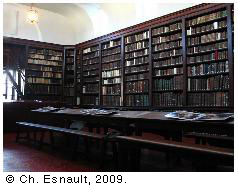
In order to attract the attention of professional and amateur researchers, as well as students who might be interested by the topic, it seemed appropriate to digress slightly. The conservation and restoration programme is a priority for the CCI and cannot be carried out in just a few years. It is thus right that the latter’s attention is concentrated upon what corresponds to very important work to facilitate researchers’ access to data which will allow them to work under better conditions.
On the other hand, it is surprising and a shame that no archaeologist has looked into this site which is however much visited and well-known. Situated in the heart of the Saint Geneviève hill area which hosts many other treasures such as the Panthéon, the Sainte-Geneviève library and Sainte Hilaire’s Cathedral, the Irish college has not been the subject of as many studies as these monuments.Not only are archaeological studies lacking, but historical uncertainties remain..
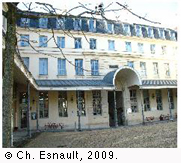 For example, the opening date for the Irish college is given by some as 1775 (Caillet M., 1991, p. 152) and 1776 by others (McDonnell J., 2002, p. 166). The date of the chapel’s consecration is never indicated. As a further example, the date of the donation of the title deeds for the land which was to accommodate the Irish College buildings is known as being 7th May 1772 (Caillet M., 1991, p. 152). So what is meant by the date of 22nd May 1772 on a deed for property donation signed by Lawrence Kelly (archive A2.a1 du CCI)?
For example, the opening date for the Irish college is given by some as 1775 (Caillet M., 1991, p. 152) and 1776 by others (McDonnell J., 2002, p. 166). The date of the chapel’s consecration is never indicated. As a further example, the date of the donation of the title deeds for the land which was to accommodate the Irish College buildings is known as being 7th May 1772 (Caillet M., 1991, p. 152). So what is meant by the date of 22nd May 1772 on a deed for property donation signed by Lawrence Kelly (archive A2.a1 du CCI)?
A further question is raised in this document, which designates a property situated on the rue des Irlandais, while this name replaced rue du Cheval Vert and should only have existed after 1869 (note that this mention seems to be subsequent to the writing of the act). These uncertainties can very probably be quickly resolved given the utility of the archives and the community’s history. On the other hand, what to say about archaeological studies which are inexistent or so confidential that the CCI was at a loss to cite a single one for the preparation of this ArkéOdyssée?
A study would however be interesting and would for example allow an evaluation of the Old Library’s current tiling, said to be original in 2002 (McDonnell J., 2002, p. 166 quoting M. Caillet, 1995) while, according to Ms Jacquet, it was converted during renovations in 2002. Far from calling the author into question, this case shows how it would be wise to quickly carry out an archaeological analysis of the building.
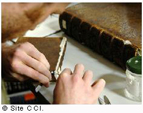 Furthermore, since the CCI is digitizing its archive collections in order to facilitate access to researchers and promoting all work touching on Franco-Irish relations, research in the scope of a Master’s degree, PhD or a serious study by an archeologist interested in in periods spanning the 18th to 21st centuries would certainly find a favourable welcome. For that matter, this is how Ms Jaquet welcomed the proposal made to her to pass on the message to universities and researchers who could be interested in the subject.
Furthermore, since the CCI is digitizing its archive collections in order to facilitate access to researchers and promoting all work touching on Franco-Irish relations, research in the scope of a Master’s degree, PhD or a serious study by an archeologist interested in in periods spanning the 18th to 21st centuries would certainly find a favourable welcome. For that matter, this is how Ms Jaquet welcomed the proposal made to her to pass on the message to universities and researchers who could be interested in the subject.
After having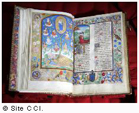 admired the illuminated codex dating from the 15th to 16th centuries (a history of the kings of England, a Flemish psalter, a book of hours of Notre Dame). presented for the occasion, a document from the collection carrying an etched bookplate and another indicator of provenance was discussed. The group was then invited to go to the pub.
admired the illuminated codex dating from the 15th to 16th centuries (a history of the kings of England, a Flemish psalter, a book of hours of Notre Dame). presented for the occasion, a document from the collection carrying an etched bookplate and another indicator of provenance was discussed. The group was then invited to go to the pub.
After a slight detour to the former Irish chapel of the Collège des Lombards on rue des Carmes (church Saint-Ephrem-des-Syriens since 1925), the discussion continued with Dr. Gransard-Desmond over a beer, resuming discussion about the meaning of the term ‘collège’ in order to properly distinguish the community from the building, to evoke the history of the building of the Irish College and archaeological questions which are still unanswered today and tackle the difference of reasoning between historian and archaeologist, in order to understand the difference between early printed books and manuscripts and start to develop work on the archaeology of books, in order to appreciate the role of indicators of provenance which enable the collections of different colleges and seminaries assembled in the Irish College to be traced, to evoke the mythical history of street names brought up during the evening such as that of le Cheval Vert (green horse) stemming from a 15th-century dyer’s revenge on a coachman who had stolen money from him by painting his horse green… Despite the noise and music characteristic of pubs, the delighted participants eventually ate together and parted at around 11pm, making a date for the next meeting.
Some reference sites…
— Irish Cultural Centre (Centre Culturel Irlandais – CCI)
5, rue des Irlandais – 75005 Paris
T. 01.58.52.10.30 – www.centreculturelirlandais.com
Here you can find a presentation of the history of the Irish College as well as an archive catalogue and the the multimedia library catalogue (access to the multimedia library is free and open to all).
If you would like to assist at the offices and events of Saint-Patrick’s chapel, they are in English.
— Irish National Office of Tourism
33 rue de Miromesnil – 75008 Paris
T. 01.70.20.00.20 – www.irlande-tourisme.fr – info@irlande-tourisme.fr
— History of Ireland is a magazine which has articles and book reviews about the country’s history – www.historyireland.com
— L’Association irlandaise of Paris welcomes those in love with Ireland in the 14th district
22, rue Delambre – 75014 Paris
T./F. 01.47.64.39.31 – www.association-irlandaise.org
— Irish culture is a portal of links about Irish culture with sections on archeology, architecture, etc. – wwww.irishculture.ie
— L’Épicerie irlandaise is a place for the curious and those in love with Ireland wishing to shop in France without having to take the plane – www.saveursdirlande.fr
 Caillet M. (1991) : « La bibliothèque du Collège des Irlandais et son fonds de livres anciens », Mélanges de la Bibliothèque de la Sorbonne 11, Paris, p. 151-163.
Caillet M. (1991) : « La bibliothèque du Collège des Irlandais et son fonds de livres anciens », Mélanges de la Bibliothèque de la Sorbonne 11, Paris, p. 151-163. Caillet M. (1995) : « Bibliothèque du Collège des Irlandais », in : Robichon Fr. (éd.), Patrimoine des bibliothèques de France : un guide des régions – Vol. 1, Île-de-France, Paris, p. 168-169.
Caillet M. (1995) : « Bibliothèque du Collège des Irlandais », in : Robichon Fr. (éd.), Patrimoine des bibliothèques de France : un guide des régions – Vol. 1, Île-de-France, Paris, p. 168-169. McDonnell J. (2002) : « From Bernini to celtic revival : a tale of two Irish College in Paris », Irish Arts Review 18, p. 165-175.
McDonnell J. (2002) : « From Bernini to celtic revival : a tale of two Irish College in Paris », Irish Arts Review 18, p. 165-175.






